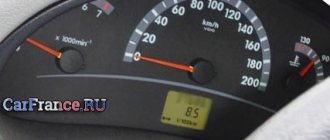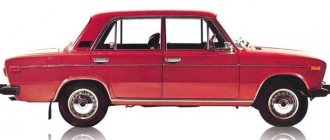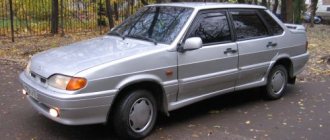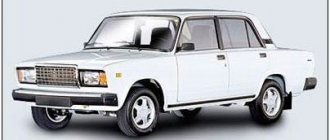VAZ-2112 is a compact car manufactured in 1999, produced at the AvtoVAZ plant in Tolyatti. The hatchback of the same name is one of the modifications of the “ten” VAZ-2110 in a sedan body. A station wagon was also produced on the basis of this model. The car was produced until 2008; on the VAZ-2112 assembly line it was replaced by the more modern Lada Priora hatchback, which is the successor to the entire “tenth” family. In addition to the five-door hatchback, the VAZ-2112 also had a three-door Coupe modification. This version was produced in limited edition.
VAZ 2112 in detail about fuel consumption
When buying a car, the owner is interested in the question of fuel consumption. The fuel consumption of the VAZ 2112 16 in comparison with other models of this car brand is considered economical and acceptable. But it is worth considering that even the driver depends on gasoline consumption for a certain distance. To understand this issue in more detail, it is necessary to consider all the reasons and nuances that affect the decrease or increase in fuel consumption. The actual fuel consumption of the Lada 2112 in the city is approximately 8 liters per 100 kilometers.
If your car's engine uses more fuel, then you need to find out all the direct factors that influence this.
VAZ-2112 owner reviews about consumption
Below are reviews from VAZ-2112 owners about fuel consumption depending on the type of engine. Standard power units have fuel consumption ranging from 5.5 to 12 liters per 100 km (depending on road congestion and driving style). Cars with boosted power units (for example, with a turbocharger or with a modified piston group) have increased power and increased fuel consumption. Depending on the compression ratio, the tank is filled with A-95 or A-98 gasoline or special racing fuel.
With 1.5 engine, manual transmission, 16 valves, 92 hp, gasoline
Kirill, 46 years old, Ekaterinburg
He was the owner of a Lada “twelfth” model with a 92-horsepower power unit. I bought the car at a car dealership in 2002 and sold it after 7 years with a mileage of 167 thousand km. Fuel consumption in urban conditions ranged from 9 to 11 liters (in summer and winter, respectively). I traveled long distances several times (more than 2000 km), the average gasoline consumption was 5.5 liters per 100 km at a speed of 90-95 km/h. Measurements were taken using the on-board computer and receipts. When driving at speeds of more than 120 km/h, consumption increased to 7 liters per 100 km.
With engine 1.6, 89 l, 16 valves, manual transmission, gasoline
Dmitry, 35 years old, St. Petersburg
I am the owner of a VAZ-2112 with an 89-horsepower engine, released in 2009, the car’s mileage is 145 thousand km. The vehicle is used to transport tools and installation materials. In summer, in traffic jams, the engine burns an average of 9 liters of gasoline, in winter, consumption reaches 12 liters, and the car is practically not used on the highway. In the winter of 2022, gasoline consumption in urban conditions unexpectedly increased to 15 liters per 100 km, and engine starting worsened. After washing the injection system injectors, replacing spark plugs, wires and flashing the control unit, the malfunction disappeared.
With engine 1.6, 81 l with 8 valves
I have been using a VAZ-2112 car, equipped with an 81-horsepower engine, since 2010. The average fuel consumption is within 8 liters per 100 km, I fill up with gasoline with an octane rating of 95. On the highway, the “appetite” of the engine depends on the speed and load of the car. With a driver and passenger at 80-90 km/h, fuel consumption does not exceed 5 liters per 100 km. Several times I traveled long distances with a trailer weighing about 700 km. According to the receipts, the average consumption was 8.8 liters; the engine power is not enough to quickly overtake slow-moving trucks or buses.
Other engines
In 2022, I owned a VAZ-2112 car with a 120-horsepower engine with a displacement of 1.8 liters. After purchasing the car, I modified it - replaced the control unit, installed a new throttle body and exhaust system. When driving calmly in the city, the car required 9-10 liters of gasoline (filled with A-95 and A-98); during sharp acceleration, consumption increased by 15-20%. On the highway at 100-110 km/h, the engine burned up to 7 liters of fuel; when the speed increased to 130-140 km/h, gasoline consumption reached 9 liters (as measured using the on-board computer).
Average fuel consumption values for VAZ 2112
When purchasing a car, you must immediately know the average fuel consumption of the engine under three main conditions.
| Engine | Consumption (highway) | Consumption (city) | Consumption (mixed cycle) |
| 1.5 5-mech | 5.5 l/100 km | 9.1 l/100 km | 7.6 l/100 km |
| 6 l/100 km | 10 l/100 km | 7.5 l/100 km | |
| 5.5 l/100 km | 8.8 l/100 km | 7.2 l/100 km |
The first is the fuel consumption of the VAZ 2112 on the highway, which averages from 9 to 10 liters. In rural areas, off-road - from 9.5 liters. In a combined cycle, fuel consumption on a VAZ 2112 should be at least 7.7 liters. If your VAZ car requires much more, then you should pay attention to the following points:
- like driving style;
- engine's type;
- car mileage;
- specifications;
- fuel quality.
Driving maneuverabilityVAZ
The first thing auto mechanics advise you to pay attention to when fuel consumption is high is your driving style. Lada is a car that does not tolerate slow acceleration or slow acceleration.
Engine type VAZ
The 2112 hatchback has a 1.6-liter fuel-injected engine with 16 valves. A 5-speed manual transmission is installed. For such an engine, the fuel consumption of the VAZ 2112 (16 valves) is an average of 7.7 liters.
As for the engine type. If the VAZ 2112 fuel consumption per 100 km exceeds 8 liters, then you need to pay attention:
- fuel filter;
- valve filter;
- nozzles;
- candles;
- valve;
- oxygen sensor.
You should also check the condition and adjustment of the electronics and its reliability.
VAZ 2112 1.5 16 valve 92 hp
Since 2001, VAZ-2112 cars in the VAZ-21120 version have been equipped with a 1.5-liter VAZ-21120 injection 16-valve engine. This engine developed 92 hp. and a torque of 133 Nm and was considered one of the most popular engines in the LADA 110 family. The engine was paired with a 5-speed manual transmission.
Gasoline consumption VAZ 2112 1.5 16 valve 92 hp per 100 km. Reviews
- Alexey, Moscow. I bought the car in 2013 - it was my first car. I didn’t show off too much, I took the domestic auto industry - a VAZ-2112, with a one and a half liter 16v engine. For the money it's a normal car, if you don't worry about it and take care of it. I've already driven 40 thousand km on it - it's inexpensive to repair, the main thing is that it's not the engine. Consumption is quite high - in the city on average 9 l/100 km, and if you drive - then all 12 liters.
- Oleg, Prokopyevsk. I took the VAZ-2112, “born” seven years ago, for one simple reason - my RAV4 broke down, and for a long time. So we had to look for a car to go to work, and... All the money went into repairs - I had to take it cheaper. I was surprised that in fact the car turned out to be not as wretched as everyone thinks - yes, it is much inferior in terms of comfort, but it didn’t break down much, and carried me in any weather without problems. Consumption is quite reasonable - from 6 liters on the highway to 12 liters if you want to drive around the city.
- Mikhail, Moscow. I love my “two-piece”, which I bought in 2007. I took it from the first owner - a car produced in 2003, with a 1.5 l 16v engine, 90 horses. It was completely stock, but I put a lot of effort and money into making it into a sweetie. By the way, I’ll say right away that the car drives without problems for five years, but then everything starts to break down at once. Fuel consumption depends very much on how you drive. If you calmly and without putting pressure on your slippers, it’s stable 7.5-8.0 liters per hundred square meters. If you heat it - 12 liters safely.
- Evgeniy, Kazan. I purchased the “twelfth” at the beginning of 2014 - my first car after passing my license. I drove it for six months and sold it - that’s what I had to do. I’m completely satisfied - maintenance is much cheaper than foreign cars, and gasoline consumption averages ten liters per hundred kilometers in the city.
- Sergey, Mezhdurechensk. Fuel consumption of the VAZ-2112 greatly depends not only on driving style, but also on the time of year. For comparison, if in the summer in the city there is a stable 8-9 liters, then in the winter it’s never less than 12, or even 15 liters if it’s frosty. On the highway, by the way, it doesn’t really matter – 5.5 in summer, 6.0 in winter.
- Kamil, Novokuibyshevsk. VAZ-2112, engine 1.5 16V, 90 hp, 2004. The downside is that upon purchase the body began to rust, and after six months the rest of the sores appeared. But we are not afraid of difficulties - the car has been in the garage for six months and is as good as new - all that remains is to make the body. Consumption on average is 6.5 -7.5 liters per hundred square meters, no more.
- Anatoly, Barnaul. The car, like the entire domestic auto industry, is rare guano. Maybe I got one - but it’s just tough. I bought it in 2010, manufactured in 2000. It’s clear that it’s old, but even an old car can’t break down like that. I suffered with it for about a year, threw the same amount into it as I bought it for and barely sold it at a loss. Plus it consumes a lot of gasoline - in the city it’s at least 9 liters, on the highway about 7 liters.
Car mileage
A very important point is the mileage of the car, as well as its condition. If this is a new car from a showroom, then all average fuel consumption indicators should match. If the car’s mileage has exceeded 100 thousand kilometers, then gasoline consumption may exceed the average.
It also depends on where the car was driven, on what roads, at what pace, and whether the engine was repaired. To find out exactly what gasoline consumption on a VAZ 2112 will be under your driving mode, fill the tank with 1 liter and check how far you can drive. Car mileage is the total number of kilometers that the car has traveled without repairing the engine and its main components.
Machine Specifications
A Russian passenger car with a hatchback body with easy maneuverability, it has fairly good factory technical characteristics. In order for fuel consumption to remain constant and not increase, it is necessary to monitor the technical characteristics of the entire vehicle. Inspection at service stations, as well as computer diagnostics will help you with this.
Fuel quality
The fuel consumption at idle speed of the VAZ 2112 is affected by the quality of gasoline, as well as the ketone number of the liquid being refilled. An experienced driver can safely say that he noticed how fuel consumption changed not depending on driving style
, not from the engine or even from the filters, but from high-quality fuel. When driving a VAZ 2112, you should take into account its mileage, as well as what you put in the tank. Accordingly, the amount of fuel consumption is determined from this.
How to regulate fuel consumption on a VAZ 2112
We have already considered the factors and reasons that affect the use of gasoline in the VAZ 2112. Now you need to know what needs to be done to prevent gasoline consumption from increasing or how to reduce it. The main points to prevent increased fuel consumption are:
- constantly change the fuel filter;
- monitor the operation of the engine system;
- change candles that become black and oily over the years - non-functional;
- watch the condition of the fuel pump mesh so that it does not fall into the glass;
- The catalyst and exhaust must function.
By adhering to these rules, you can save on fuel costs for the VAZ 2112 by 7.5 liters.
Basic rules for reducing gasoline consumption
An attentive driver must constantly monitor all indicators of the car. Monitor the oil level, monitor engine operation, and monitor all filters and strainers. If you bought a car that has already traveled a certain number of kilometers and its fuel consumption exceeds 10 liters, then you should immediately take the following actions:
- change oil (adjust level);
- replace the filter;
- check the quality of gasoline;
- observe the performance of the fuel pump;
- regulate driving maneuverability.
If all this does not lead to the desired result, then you need to do computer diagnostics of the car.
Fuel consumption at idle
When working with a stationary vehicle, fuel consumption depends on the following factors:
- cylinder block and throttle body temperatures;
- condition of injector nozzles and air filter;
- settings of the program recorded in the memory of the control unit;
- general condition of the engine piston group and gas distribution mechanism;
- degree of load on the crankshaft.
For example, the fuel consumption of a VAZ-21124 during a cold start in winter (temperature -20°C) reaches 1.5 liters per hour. As the engine warms up, the control unit adjusts the mixture composition, reducing the parameter to the standard 0.7-0.8 liters. Turning on electrical consumers (for example, a powerful sound system or high beam headlights along with fog lights) increases the load on the generator and automatically increases the idle consumption to 1-1.1 liters per hour.
Fuel consumption VAZ 2112
Onion rings stuck between car seats don't smell better over time.
VAZ 2112 is a hatchback version of the 2110 model, which resulted in a separate model. It has been produced since 1999, and stopped coming off production lines in 2008. The car could be either a five-door or a three-door. The model differs from the sedan in a shortened body, thanks to which control and acceleration have become better, as well as a trunk enlarged due to special technologies, the volume of which is almost 400 liters.
VAZ-2112 engines
The VAZ-2112 car is a popular hatchback from AvtoVAZ. From the factory it was configured with different engines:
- 16-valve , 89-horsepower, with a displacement of 1.6 liters, marked as 21124 . (A distinctive feature is that this engine does not bend the valves when the timing belt breaks).
We will make a replacement on this engine (21120)
All engines are paired with a five-speed manual gearbox.
Judging by the great popularity of this car among car enthusiasts, it is distinguished by high reliability and high performance characteristics.
Official data (l/100 km)
| Engine | Consumption (city) | Consumption (highway) | Flow (mixed) |
| 1.5 MT 72 hp (Mechanics) | 9.0 | 5.6 | 7.3 |
| 1.5 MT 78 hp (Mechanics) | 10.0 | 5.7 | 7.3 |
| 1.5 MT 92 hp (Mechanics) | 9.8 | 6.1 | 7.4 |
| 1.5 MT 94 hp (Mechanics) | 9.4 | 5.9 | 7.1 |
| 1.6 MT 81 hp (Mechanics) | 10.0 | 6.0 | 8.5 |
| 1.6 MT 90 hp (Mechanics) | 9.4 | 5.9 | 7.1 |
| 1.8 MT 98 hp (Mechanics) | 10.0 | 6.0 | 8.5 |
The VAZ 2112 was equipped with several types of engines. In fact, there were only three of them, but due to various modifications their power varied greatly. The first engine is 1.5 liters. The version, which had a total of 8 valves, could develop a power of 72 horsepower. Fuel consumption per 100 km here was at around 7.2 liters. The 16-valve version showed slightly more power – 92 hp. Gasoline consumption for this configuration was also around 7 liters.
The next engine is 1.6 liters. The eight-valve configuration produces 81 horsepower, and the sixteen-valve configuration produces 90 hp. These engines have increased consumption, prescribed at 8 liters. Well, the largest engine is 1.8 liters. It has only one version, with a capacity of 98 horsepower. Its average consumption was 8.5 liters. All engines were paired with only a manual transmission operating in five modes.
VAZ 2112 1.6 8cl. 81 hp
The version with the VAZ-21114 engine received the factory index VAZ-21211. It was a 1.6-liter 8-valve fuel-injected engine capable of producing 81 hp. and a torque of 129 Nm. The engine had a number of shortcomings, so after some time it was replaced by a more reliable and economical 16-valve modification.
Reviews about fuel consumption of VAZ 2112 1.6 8kl. 81 hp
- Roman, Sochi. I bought it from one representative of the mountain people in 2012 - it was tuned to the best of my ability, forward flow, ProSport optics, new seats, lowered suspension, low-profile tires, completely noise-free, and the like. It roars like a beast, and the engine is a regular 1.6-liter 8-valve engine. In general, there is an external gloss, but there is little sense. Consumption 8-9 liters, up to 10 maximum. I drove it for six months and sold it to the same “ara-tuning” lover as the one from whom I bought it.
- Alexey, Slavyansk-on-Kuban. I bought my VAZ-2112 in 2003. I took it with a 1.6 liter engine - I think it is better than 1.5 liters. I drove it for almost 10 years – it was like my own. An excellent car for the city and suburbs, fuel consumption is up to 9 liters, on the highway generally 6 liters.
- Nikolay, Ulyanovsk. Lada “twelfth”, 2004, with a 1.6 liter eight-valve engine. At first I was delighted after the purchase, but very, very soon I had an epiphany. The only plus is the high ground clearance and that’s it. Everything else is rare hemorrhoids. The interior is completely miserable, everything rattles and knocks, something constantly breaks, and normally no one repairs this squalor at all. Gasoline consumption is normal - 8-9 liters consistently in the city, on the highway 6.5 liters.
- Maxim, Noyabrsk. Don't be fooled by the fact that spare parts can be bought at any store. Yes, you can buy them there - but they are of even worse quality than Chinese ones. You buy, install, and after two or three months you have to buy and install again. And so on with each node. The only thing they did right was the ground clearance; they made it quite high for our roads. Expected consumption – highway from 5.5 to 6.5 liters, city from 7 to 10 liters.
- Grigory, Bratsk. Everyone complains about the domestic auto industry, but I like the “two-wheeler”. I bought it back in 2006 - a three-year-old VAZ-2112 with an 8-valve 1600 cc. A couple of years later I sold it and took the same one, but 16v. I will say that I didn’t see much of a difference either in consumption or in dynamics - my first “two-wheeler” was peppy and consumed 7-8 liters of gasoline on average in the city.
Owner reviews
“I decided not to spend money on my first car and bought a VAZ 2112. I’ve been driving it for 10 years. If you take care of the car, as I do, then it will live for a very long time. He never let me down, although the situations on the roads were different. The only thing I don't like is the design, it's too simple. But everything in the cabin is great. There is a lot of space, it is well equipped, and there is a lot of useful stuff on the dashboard. I will also note the build quality, which is not typical for our cars. The engine is peppy and drives well, both on regular roads and off-road. Too bad it's a big expense. I spend up to 11 liters of fuel,” writes Georgy from Krasnodar.
This review was left by Kirill from Rostov:
“To my great regret, my old car broke down for good. I urgently needed some kind of car to carry out normal everyday tasks. There wasn't a lot of money, since most of it was spent on repairing the previous car. I had enough for the VAZ 2112. I can’t say anything bad about the car, it’s a worthy model. There is plenty of space for both passengers and things in the trunk. The engine allows you to drive at a decent speed on the highway, and also feel comfortable in the city. It uses a lot of fuel, but the car is good.”
“My father gave me the car after he bought himself a new foreign car. My joy knew no bounds, since I received my license a long time ago, and there was nothing to constantly practice on. I like everything about the car. A pleasant rounded design, a modern and spacious interior and a peppy engine evoke only positive emotions. I was impressed by the sound insulation, which does not allow sounds from the street to pass through at all. I travel very often, so I use a lot of fuel. In the summer I spend up to 12 liters in the city, a little more with air conditioning. In winter it’s about 13,” notes Nikolai from Yekaterinburg.
And this is what Artem from Smolensk writes about his car:
“I bought the car from a dealership in 2005. I drove it for almost five years and decided to sell it. But I did this solely in order not to spoil the impression of our cars, since by this period of use various problems usually begin, and I don’t want to tinker with the car. I was completely satisfied with it and saw no shortcomings at all. I would like to note that the interior was quite modern in terms of equipment, which made us proud of our auto industry. Here you can find high build quality, good sound insulation, and pleasant finishing materials. Consumption varies greatly and depends on the time of year. In winter, on average, it was 11-12 liters, in summer – up to 10.”
“Before I was twelve, I had several cars, but there were problems with all of them. However, here, to my surprise, everything was smooth throughout the entire time of use. I have never been to a service center, I changed all the consumables myself. I was surprised by the technical equipment, which is characterized by high reliability and good cross-country ability on any road conditions. The engine would be a little more powerful, and you simply couldn’t find a better car, especially at such a low cost. One moment, of course, spoiled the impression a little. This is a consumption that could reach 13 liters in the city and 10 on the highway. This is too much for such a small engine,” writes Vladimir from Tver.
The car received these words from Vitaly from Abakan:
“I didn’t like the car at all. I struggled with it for a couple of years and sold it. Yes, there are a lot of spare parts for it and they are cheap. But, first of all, this means that they will have to be changed very often. I bought it, installed it, drove it a little and everything was new again. The only positive thing about the car is the interior, which has more or less decent equipment by the standards of that time. The car’s consumption was up to 12 liters.”
VAZ 2112 1.6 16 cl. 89 hp
The latest and most popular model is the VAZ-2112, equipped with a VAZ-21124 engine. This is an injection 4-cylinder engine with a volume of 1597 cm3, having 4 valves per cylinder. The engine developed a power of 89 hp. and a torque of 133 Nm. It has a modernized design that eliminates the main problems of the 8-valve version, in particular the problem with valve bending
Fuel consumption VAZ 2112 1.6 16 cl. 89 hp per 100 km. Reviews
- Alexey, Chelyabinsk. Sixteen-valve VAZ-2112, 2005. I bought it new, sold it five years later and don’t regret the purchase or sale one bit. During all this time I hardly bothered you, but five years is the deadline for the domestic automobile industry, then sex with the car begins, and why spoil the impression? So I sold it and am happy. By the way, its consumption is less than that of the “ten” - on average I got 6.5 liters in the city, but I drive calmly.
- Timur, Pervouralsk. VAZ-2112, 2007, engine 1.6 16V, 90 hp. For the money, the car is not bad - it’s really made for our roads, and it looks more interesting than the “ten”. But the build quality is a quiet horror - everything that can rattles. In terms of consumption - highway 5.5 l, city 8.5 l, in winter maximum 10 l.
- Semyon, Krivoy Rog. Before the “Dvenakh” there was the Volga 29 - you can’t compare them at all. “Dvenakha” in comparison with it is just some kind of foreign car. I bought it in 2012, four years old. The condition is normal - as normal as it can be for our car. Consumption is from 7 to 10 liters, there is Shumka, nothing particularly knocked. I took it while I was riding and am happy.
- Artem, Salavat. A really simple and problem-free car, no matter what anyone says. Probably one of the most successful AvtoVAZ models. At speed the car is stable, does not throw it, the power of the 16-valve engine is enough for the eyes. Another plus is the high ground clearance; some city crossovers have lower ground clearance. Well, it’s economical - on the highway the consumption is 5.5 liters, in the city from 7 to 9 liters.
- Vitaly, Anzhero-Suzhensk. I bought my VAZ-2112 2007 six months ago. I haven’t really gotten into it yet - I made a Shumka, installed good acoustics, and also replaced the steering rack. There are no problems with consumption - if you heat in the city, then nine liters is the maximum, but if it’s calm - then six or seven liters, no more.
- Kirill, Abakan. "Dvenakha" 2006. Consumption is from 6 to 8 liters per 100 km, and in the city, if you don’t heat it, it’s very economical. In winter, consumption increases by about 2-3 liters, depending on frost.
- Anton, Tyumen. I always liked the “Dvenashki” - but the first time I bought a bad one, it turned out to be after a serious accident, it was hastily adjusted and that’s it, but I wanted to buy a car so much that I didn’t look carefully - I was attracted by the price. Six months later I realized the mistake, but I liked the model itself. Therefore, when choosing the next “two-piece”, I looked more carefully and made the right decision. What I like most about it is the engine - a reliable and simple sixteen-valve engine, it worked like a clock, even though the car is from 2007. If they did the same for the bodies, there would be no price. Consumption is normal - on the highway up to 6 liters, in the city up to 10 liters.
- Mikhail, Volgograd. I believe that if you buy a VAZ, you don’t need to show off and spoil it with collective farm tuning. The car is already normal - a good and inexpensive means of transportation, there is no need to make a circus out of it. Yes, the build quality is not great, the finishing materials are very cheap - and for the price it’s not a Rolls-Royce or even a Toyota. An ordinary car for the average citizen of our country. But everyone can afford it - spare parts are cheap and consumption ranges from 7 to 10 liters.
- Pavel, Samara. I drove a VAZ-2112 for a year and realized that cheap spare parts do not mean cheap maintenance - it means that you will constantly buy spare parts for the car, and they will constantly break down. Over the course of a year, I repaired the entire chassis, oil system, and went through the electrical system. After the consumption jumped to 15 liters in the city, I finally saw the light - it turned out that the air flow sensor burned out, I had to buy a new one so that the consumption dropped to 10 liters. In general, the car is for a novice driver.
- Roman, Izhevsk. My VAZ-2112 with a 1.6 16-valve engine is the most economical car I've ever owned. Consumption on the highway is 5.5 liters in total, in the city a maximum of 11.5 liters (this is in winter). The model with this engine is truly the most successful.
What is the approximate fuel consumption per 100 km on a VAZ-2112
Considering the fact that price tags at gas stations change only in one direction - growth - the fuel consumption indicator today is one of the main ones when choosing a car.
In addition, during operation, many owners wonder whether their iron horse eats too much. It should be noted that domestic cars, such as the VAZ-2112, are considered inexpensive to operate. Their design is very simple, without any complex electronic devices, and the prices for spare parts are quite reasonable. Accordingly, engine efficiency begins to come to the fore.
VAZ-2112 – what should be normal fuel consumption?
In order to find out how much gasoline the “twelfth” consumes per hundred kilometers, you should refer to its passport data. The manufacturer, in particular, gives an average figure of 7.5 liters per hundred. However, a car's fuel consumption depends on many factors. For example, the Volzhsky Automobile Plant installed three types of engines on the “twelfth”:
- 21121 – 1.5-liter, 80 horsepower, 8 valves;
- 21124;
- 21120.
The last two engines are 16-valve. The volume of 21124 is 1.6 liters with a power of 89 horsepower. It should be noted that here, if the timing belt breaks, the valves do not bend. Finally, 21120 is a 1.5-liter engine with 93 horsepower.
A distinctive feature of this power unit is the steel receiver. One of the disadvantages is that the valves bend when the timing belt breaks.
It should be noted that the consumption of each of these engines also depends on the brand of fuel. For example, when driving an AI-92, this figure is 9.12 liters per 100 kilometers. By filling the tank with higher octane fuel, you reduce its consumption. In particular, with AI-95 gasoline, consumption is reduced to 7.4 liters. An even more noticeable effect in terms of savings is noticeable on premium varieties. In particular, by filling AI-95 Premium gasoline, you will reduce fuel consumption to 6.5 liters. All data is given for the “mixed cycle” mode.
It should be noted that it makes no sense to cite the figures announced by the manufacturer. Real consumption always differs greatly from the passport data. Also, do not forget that driving in urban conditions with heavy traffic significantly increases gasoline consumption. At the same time, on a suburban highway you can travel most of the way in 5th, direct gear. Accordingly, the appetite of the iron horse is significantly reduced.
Fuel consumption differs in winter and summer. In the first case, you often have to fight your way through snowy streets in 1st and 2nd gears. In addition, until the coolant temperature rises to operating temperature, the engine will operate at higher speeds. All this also does not contribute to savings.
A very important point is driving style. With an aggressive style, with sharp acceleration and frequent braking, fuel consumption increases quite seriously. Therefore, if you do not want to overpay for each kilometer of travel, it is better to move more smoothly without revving the engine. Don't get too carried away when pressing on the gas. The most optimal mode in terms of fuel consumption is 5th gear at a speed of 90-100 kilometers per hour.
It should also be noted that fuel consumption can increase significantly due to technical problems. There could be a great many reasons for this. If you find yourself in such a situation and intend to independently find and eliminate the reason for the sudden increase in gasoline consumption by your car, then follow the rule “from simple to complex.” First of all, it is recommended to check the fuel filter. Often it is its clogging that leads to an increase in appetite. Don't forget that it needs to be changed at regular intervals. Consumption may also increase due to dirt getting into the injectors. In this case, you most likely cannot do without a visit to a car service center. It is not recommended to clean injectors yourself if you have never done this before. Believe me, it’s better to pay professionals for the work here.
Pay attention to the fuel pump mesh - it may well become clogged due to low-quality fuel. Also, when identifying the cause of the increased consumption, you will need to check the performance of a number of sensors - idle speed, speed, camshaft, and so on. Keep an eye on the numbers on the on-board computer - you will often see a prompt with an error code there. Also carefully inspect the spark plugs for carbon deposits and ensure the integrity of the high-voltage wires. By the way, a clogged air filter may well lead to an increase in consumption. As you can see, there are really many reasons, and we have not listed all of them, but only the most common ones.
Well, in conclusion, I would like to give some advice on how to prevent gasoline consumption from going beyond normal limits. Firstly, always carefully monitor the technical condition of the car. Secondly, try to keep your eating style as smooth as possible. Thirdly, do not try to save money by refueling at dubious gas stations - the consequences can be very serious.
What engines are installed on the VAZ-2112
The following engines were installed as standard on the vehicles:
- basic 8-valve 2111 with a volume of 1.5 liters and a power of 77 hp. With. (the modification was distinguished by the use of solid front brake discs without ventilation ducts);
- the improved version of the GLI used a 91-horsepower engine 21120 (16 valves, 2 camshafts, volume 1.5 l);
- after the modernization of power plants in 2004, the base models began to be equipped with an 82-horsepower 1.6-liter engine 21114 with an 8-valve valve timing;
- since 2004, a 16-valve 21124 with a volume of 1.6 and a power of 89 hp began to be used. With. with a modified piston group and an improved crankshaft;
- cars with a 1.8-liter 21128 were assembled in small batches (power 98 or 123 hp, depending on the settings of the control unit and the profile of the camshaft cams).
All power units are built on the basis of a unified 4-cylinder block; a liquid cooling system with forced circulation of antifreeze is used to maintain the required temperature. Until 2004, a sports modification of the 112-37 hatchback, equipped with a boost of up to 100 hp, was assembled in small batches. With. engine 21120. The cars were distinguished by the design of the box with a locked differential, the interior was equipped with sports seats with seat belts and a welded frame made of pipes to protect the driver in case of rollover.
Depending on the year of manufacture, engines use different exhaust manifolds. Until 2004, the catalytic converter was installed separately, the exhaust toxicity complied with Euro-2 standards. With the start of production of 1.6-liter power plants, a manifold with an integrated catalyst and 2 oxygen concentration sensors began to be installed (the toxicity standard increased to the Euro-3 standard). Removing the neutralizer reservoir from under the underbody made it possible to increase the ground clearance by 10 mm.
The engines are equipped with a forced ignition system with electronic adjustment of the spark timing. On 8-valve models and the 21120 engine, a common module is used with coils connected by wires to the spark plug tips.
The 21124 power unit uses individual coils inserted into the spark plug wells on the gas distribution mechanism cover.
Key points regarding gasoline consumption
The main indicator that affects the fuel consumption of a car engine is engine volume. Gasoline consumption for the VAZ 2111 on the highway with a 1.5 - 5.5 liter engine, and with a 1.6 - 5.6 liter engine.
Fuel consumption for a VAZ 2111 in the city with an engine of 1.5 - 8.8 l, 1.6 - 9.8 l.
As you can see, the larger the engine volume, the higher the fuel costs. Motor modifications are designed for better performance and efficiency. In a combined cycle, the engine uses up to approximately 7.5 liters. Also very important is the maneuverability of the ride, the character of the driver. With calm, moderate driving, you can save up to 1.5 liters on the highway and in the city.
VAZ 2112 1.5 8v, 1.8
Other power units were also installed on VAZ-2112 cars. The first models were equipped with an injection 8-valve 1.5-liter VAZ-2111 engine, which had successfully proven itself on models of the “ninth” series, capable of producing power of 77 hp.
In addition, a modification of the VAZ-21128 was produced in a small series. It was equipped with a powerful 1.8-liter injection engine capable of producing 105 hp. and a torque of 162 Nm. Without exception, all engines were equipped with a 5-speed manual transmission.
Car mileage
A very important point is the mileage of the car, as well as its condition. If this is a new car from a showroom, then all average fuel consumption indicators should match. If the car’s mileage has exceeded 100 thousand kilometers, then gasoline consumption may exceed the average.
It also depends on where the car was driven, on what roads, at what pace, and whether the engine was repaired. To find out exactly what gasoline consumption on a VAZ 2112 will be under your driving mode, fill the tank with 1 liter and check how far you can drive. Car mileage is the total number of kilometers that the car has traveled without repairing the engine and its main components.
How to reduce fuel consumption
Real fuel consumption on the 16 valve Lada 2111 is about 6 liters per 100 km
. In order not to exceed the threshold of this figure, it is necessary to carefully monitor the technical characteristics of the car, the engine and the entire operation of the machine.
Mandatory actions for caring for the operation of the motor system
- replacing the fuel filter;
- cleaning injectors;
- timely oil change;
- generator cleaning.
Computer diagnostics will help identify causes and reduce fuel costs. It is also necessary to adhere to traffic rules and calm, moderate driving.
Reasons for increased consumption
The on-board computer screen shows increased fuel consumption
The increase in engine fuel consumption on the VAZ-2112 is identical to all other engines of any family of cars. But it is worth considering this issue in more detail. So, what are the reasons for the increase in consumption:
- Fuel system malfunction.
- Problems with the injector.
- The fault lies in the catalyst.
- Air filter dirty.
- Engine temperature.
- Sensors and ECU.
Once the reasons have been determined, you can begin step-by-step repairs.
Methods for solving the problem
To eliminate increased fuel consumption, it is worth understanding the design features of not only the main power unit, but also the auxiliary systems on which the operation of the engine as a whole depends. Thus, several systems become the causes at once. But how can we determine where exactly the malfunction occurred? To do this, consider the sequence of diagnostic and repair actions for systems.
Sensors and ECU
When any engine malfunction occurs, the first place you need to “climb” is the electronic control unit.
Often, errors are hidden here, and you can also see where the problem is hiding. To perform diagnostics, you need to connect via a tablet or laptop to the “brains” of the car using a USB – K-line cable.
Diagnostics through the instrument panel of VAZ-2112
A transcript of the errors that could be seen in the video is given below in the picture.
ECU error codes and their interpretation
The first reason may be accumulated errors in the block itself, where the commands already contradict each other, and the injectors began to supply an increased amount of the fuel mixture. The treatment is simple - resetting errors or installing a new operating system. Many car owners recommend Paulus.
If resetting the ECU errors did not help, then it is worth checking the functionality of the sensors that are responsible for the air-fuel mixture, namely:
- Mass air flow sensor.
- Lambda probe.
- Throttle position sensor.
- Temperature sensor.
Engine control circuit and sensors
It is these sensors that can cause fuel consumption to increase. If diagnostics show that one of them is faulty, it must be replaced. If, however, the consumption remains the same, you need to move on and look for the problem in another unit.
Fuel system
It is in the fuel system that the mystery of increased engine fuel consumption may lie. First of all, you need to check the pressure in the fuel pipes and fuel rail. Several parts that have failed for various reasons can contribute to this effect.
Dirty fuel module mesh
The first two items to check are the fuel pump and the fuel filter. Dismantling the fuel module may be a clue, since the filter mesh could simply be clogged. But the filter is not visible, so you just have to change it. Low-quality fuel, which is saturated in the modern gasoline market, as well as low-quality spare parts can cause this unit to fail ahead of time.
Dirty fuel filter
You should measure the compression in the cylinders. When compression decreases, engine power decreases and in order to achieve the dynamics we are accustomed to we have to press harder on the trigger, and hence increased consumption. Reasons for decreased compression: wear of the cylinder-piston group, leaky fit of the valves to the seats, coking of the piston rings. If in the first two cases you can’t do without opening and repairing the engine, then in the third case, at the early stage of coking of the piston rings, you can use a decoking agent, for example “LAVR-anticoke”. The MAF (mass mass sensor) can also tell you about the condition of the piston group air flow) on an injection engine, provided that it is in good condition. It is enough to connect the computer and compare the current readings of the sensor with the readings that should be for a specific ECU (electronic engine control unit), for example: ECU January 4.1 at an engine speed of 750-850 should consume air 7-8 kg/hour, if the values are lower, then this can already indicate wear of the cylinder-piston group; the lower the reading, the greater the wear.
Black carbon deposits on the spark plugs indicate an enriched fuel mixture; in this case, the fuel does not burn completely and the remains of unburned fuel fly out into the pipe, and therefore increased consumption. True, to say that the fuel does not burn completely due to the enriched composition of the fuel mixture is not entirely true; it would be more honest to say that in such a situation less fuel is burned than it should be, since in a fully operational, naturally aspirated engine, roughly speaking, half of the incoming fuel is burned fuel. Reasons for over-enrichment of the fuel mixture: for a carburetor engine - the air filter is clogged, the carburetor is clogged or incorrectly adjusted, for an injection engine - the air filter is clogged, incorrect readings of the mass air flow sensor, incorrect readings of the DTOZh sensor (coolant temperature sensor). There is one more malfunction that will affect the over-enrichment of the fuel mixture, although I don’t know how relevant it is for a carburetor engine, but it will definitely affect the fuel consumption of the injector. This malfunction is a thermostat in which the valve opens completely, earlier than it should, in this case, the engine will not heat up to the required operating temperature, the ECU sees that the engine is not warmed up and will supply a rich mixture.
Light carbon deposits on the spark plugs mean that the fuel mixture is lean; here a similar situation arises as with a decrease in compression, engine power decreases. For a carburetor engine, the reason for a lean mixture lies again in a malfunction, blockage, or incorrect adjustment of the carburetor. The injector has: sensors - mass air flow sensor and air pressure sensor, low pressure in the fuel line. Low pressure occurs when the fuel pump is worn out, when the fuel pump strainer is clogged, or when the fuel filter is clogged.
Other reasons for increased fuel consumption due to the fault of the injector fuel system: the fuel return valve does not work, the injectors are leaking, the injectors are clogged - because of this, the injectors do not atomize the fuel well, and as a result, the quality of the fuel mixture is poor, which reduces engine dynamics.
And if your fuel consumption has increased in winter, this is normal. Reasons: increased engine warm-up time, increased load on the engine due to an increase in the viscosity of the oil in the engine and gearbox, the same thing happens with the grease in the bearings of hubs and grenades, rapid cooling of the engine, the interior heater is constantly running, frequent wheel slipping on snow and ice. Winter fuel consumption is definitely higher than when operating in a warm period; consumption may increase slightly, or it may be shocking. For example, I have a VAZ 2110 1.5 injector, fuel consumption per 100 km, when driving long distances, increases by 1-2 liters, and when driving short distances of 2-5 km, fuel consumption doubles. At the same time, my summer consumption is according to my passport.
Fuel consumption is also affected by an increase in the weight of the car, for example, they set the music to 50 kilograms, flat tires, the tires themselves, incorrect wheel alignment, and driving style.
Influence of time of year, temperature and sensor serviceability
Again, a lot depends on the time of year. In winter, every vehicle uses much more fuel. This is due to the long warm-up of the engine, the condition of the road surface, and periodic slipping. In the summer months, the basic consumption rate decreases if you do not keep the windows open when driving at high speeds.
Another reason has to do with the functioning of the sensors. If they are set incorrectly, they will not be able to correctly calculate the sufficient volume of the air-fuel mixture, as required by the engine control unit. This is an oxygen sensor, an air metering sensor and others. As a result, an overly enriched mixture begins to form, which empties the tank in a short time.
The first cars in this series have a carburetor engine, which can be manually adjusted to reduce fuel consumption. It will not be possible to set up an injection engine in the same way. However, it is periodically necessary to look into the injectors of the power unit and check whether they are clogged. If clogged, they begin to spray more gasoline, while the quality of the working mixture remains low.
It is known that the normal temperature of the power unit should be in the range of 90–100 degrees Celsius. As soon as it starts to overheat, the mixture becomes unnecessarily discharged. Engine power immediately drops, which leads to excessive fuel consumption. There is also the concept of “instant fuel consumption,” which is reflected on the trip computer screen. But unfortunately, not all cars are equipped with it. This indicator is influenced by the speed of movement and engine speed. In some cases, it can amount to tens of liters per hundred kilometers, but you should not be afraid of this, since we are talking only about the every second value when accelerating the car in low gears.
With this we will say goodbye. Subscribe to blog updates to continue receiving interesting newsletters. See you again, dear car enthusiasts!
Sincerely, blog author Andrey Kulpanov
Place for contest advertising Andrey Views: 17059 3 Likes Share 1 comment
A headache for motorists is high gas mileage. Prices at gas stations regularly increase, so more and more of the family budget has to be spent on fuel. Although sometimes it is enough to devote a couple of hours to your iron horse for diagnostics with easy repairs, and this time will return in the form of saved liters per hundred kilometers.
Of all the consequences that affect efficiency parameters, it is customary to distinguish two main reasons for high fuel consumption:
- direct (poor performance of individual components or elements, as well as their complete failure to operate);
- indirect (factors that are largely not directly related to design changes during operation).
Owner reviews
“I liked the car because it was spacious, and this was the main parameter by which I chose a car. As it turned out later, he also drives well. The car is already more than 10 years old, and it has never broken down yet, which is quite strange for our models. I use it often, mainly around the city for various work tasks, but sometimes I have to travel long distances, for example, to the country. The model shows itself only from its best side everywhere. As for consumption, everything is a little bad. I have a 1.7 liter engine. It eats up to 15 liters in the city,” writes Alexey from Novgorod.
“I bought this car from a neighbor because I urgently needed a car that has a lot of space. Initially I doubted it, but when I drove it a little and saw the consumption, I took it without any doubt. Now I often drive it for work purposes, transporting small loads. I also sometimes travel to the countryside, since the trunk and interior can accommodate all the tools and various seedlings. In terms of consumption, I’ll say that I’ve never spent more than 10 liters,” says Vasily from Tyumen about his car.
“I won’t say that I am the proud owner of this car, since it often lets me down and breaks down at the most inopportune times. I have already spent a lot of money on its repairs and maintenance, and I even thought about selling it. Although it’s a shame, since this is an excellent work car in which you can fit everything and safely drive it to your destination, while consuming a minimum of fuel. I only spend 9 liters, no more,” wrote Alexander from Penza.
“I bought a VAZ 2111 secondhand from an advertisement. I got it in good condition, which I am incredibly happy about, since our cars are hard to kill. I only use it for driving around the city, as I work as a delivery person for various things. I haven’t used it on the highway, and I don’t want to, since the engine is barely enough for the city. And he eats quite a lot; consumption can easily reach 12 liters. I think it’s worth flashing the engine, maybe it will help,” said Ruslan from Rostov.
“I use this car to transport various construction materials to my dacha. You can't think of a better vehicle for this task. It's easy to care for, hard to kill, and it only eats a pittance of fuel. It’s a pity that it’s sparsely equipped, but it would be too much if they had put in a luxurious interior for such a low price. The engine and suspension leave a good impression. I have a configuration with a 1.8 liter power unit and all-wheel drive. It’s impossible to get stuck in a car, unless, of course, you deliberately go into the wilds,” Ignat from Pskov wrote about his car.
“My father gave me the car when I got my first job as a courier. It was very useful to me and made my life a lot easier, since there is a lot of space in it, I could easily store all my goods for the day, it drives briskly, and consumes little fuel. Although many, as I read in reviews, complain specifically about the consumption, but for me it has never been more than 11 liters,” this review was left by Evgeniy from St. Petersburg.
VAZ fuel consumption is always acceptable. The developers are seriously thinking about reducing fuel consumption for different VAZ brands.
VAZ cars are domestically produced cars. VAZ is a Volga automobile plant, it is located in the Samara region in the city of Tolyatti. VAZ cars are distinguished by moderate fuel consumption and affordable prices.
VAZ fuel consumption.
VAZ fuel consumption is always acceptable. The developers are seriously thinking about reducing fuel consumption for different VAZ brands.
VAZ cars are domestically produced cars. VAZ is a Volga automobile plant, it is located in the Samara region in the city of Tolyatti. VAZ cars are distinguished by moderate fuel consumption and affordable prices.
Data on VAZ fuel consumption are described below in the table on fuel consumption of VAZ cars. VAZ cars are not only a means of transportation, but also an integral part of everyday human life.
Fuel consumption of a VAZ depends on its modification (brand), driving style and time of year. The table below shows the average fuel consumption of the VAZ brands of the 2107, 2114, 2110, 2106, 2112, 2109, 2115 family.
Table of fuel costs for VAZ brands.
The table describes the average costs for different VAZ brands . Fuel consumption is presented in three types - city, highway and mixed (average) fuel consumption. All data on fuel costs are from the VAZ car manufacturer. For almost all brands of VAZ cars, fuel consumption does not exceed 10 liters per 100 km, with the exception of the carburetor Niva.
Average fuel consumption VAZ
liter/100 km
120 km/h=10
120 km/h=9.8
| Brand VAZ | Power, hp | City | Route | |
| VAZ 2101 (1.2, carburetor) | — | 10.5 | 11 | |
| VAZ 2102, 2103 (1.5, Carburetor) | 71 | 11 | 11.5 | |
| 2106 (1.57 engine, carburetor, four-speed gearbox) | 76.4 | 9.5 | 10.5 | 8.5 |
| 2106 (1.45 engine, carburetor, four-speed gearbox) | 73.5 | 9.9 | 10.8 | 9.0 |
| 2106 (engine 1.6, injector) | — | 8.4 | 9.8 | 7 |
| 2105 (1.3, carburetor) | 64 | 9.1 | 10.2 | 8.1 |
| 2105 (1.5, carburetor, four-speed gearbox) | 71.1 | 8.8 | 9.5 | 8.0 |
| 2107 (1.6, injector) | — | 7.8-9.8 | 9-11.5 | 6.7-8.2 |
| 2107 (1.6, carburetor) | — | 8.9 | 10.2 | 7.5 |
| 2107 (1.5, carburetor) | — | 8.3 | 9.6 | 7.0 |
| 2108, 2109, 21099 (1.5, carburetor) | 72 | 9.1 | 10.1 | 8.2 |
| 21083, 21093, (1.5, injector) | 72 | 7.6 | 8.5 | 6.7 |
| 2110, 2111, 2112 (1.5, carburetor) | 67.7 | 9.5 | 10.5 | 8.4 |
| 2110, 2111, 21124 (1.5, injector) | 72 | 7.9 | 8.7 | 7.0 |
| 2113, 2114, 2115 (1.5, injector) | 72 | 7.6 | 8.5 | 6.7 |
| Lada Granta (8 valve) | 80 | 7.0 | 8.3 | 5.8 |
| Lada Granta (8 valve) | 90 | 7.7 | 9.3 | 6.1 |
| Lada Granta (16 valve) | 98, 106, 120 | 8.1-10.1 | 9.2-11.2 | 7-9 |
| Lada Kalina 21117, 21118, 21119 (1.4 engine) | — | 6.9 | 7.8 | 6.0 |
| Lada Kalina 21118, 21119 (engine 1.6) | — | 7.2 | 8.1 | 6.3 |
| Lada Priora (1.6) | 90 | 7.6 | 8.8 | 6.5 |
| Lada Priora (1.6, 16 valve) | 106 | 8.6 | 9.5 | 7.7 |
| Lada Vesta 21179 (1.8, 16 valve) | 123 | 8.5-10.5 | 9.5-11.5 | 7.5-9.5 |
| Lada Vesta 21129 (1.6, 16 valve) | 106 | 8-10 | 9.0-11.0 | 7.0-9.0 |
| Lada x-Ray (X-ray, 1.6, 16 valves) | 110 | 7.9 | 8.8 | 7.0 |
| Lada x-Ray (X-ray, 1.8, 16 valves) | 122 | 8.1 | 9.1 | 7.2 |
| Lada Largus (1.6, 8 valve) | 90 | 8.6 | 9.5 | 7.7 |
| Lada Largus (1.6, 16 valve) | 105 | 8.2 | 9.0 | 7.5 |
| VAZ 21213 (Niva, 1.7, carburetor) | — | 11.5 | 13.0 | 10.0 |
| VAZ 21214 (Niva, 1.7, injector) | — | 9.8 | 11.0 | 8.5 |
| VAZ 2131 (Niva, 1.8, injector) | — | 11.1 | 12.8 | 9.5 |
VAZ has acceptable fuel consumption!
The car is given good dynamics and acceptable fuel consumption thanks to its reliable engine. VAZ has an affordable price for both a new and an old car. Old VAZ brands are acceptable to most people. The new VAZ engine demonstrates extreme efficiency, thanks to which the car has low fuel consumption and a reduced level of harmful emissions into the atmosphere.
VAZ - average quality cars, affordable price and acceptable fuel consumption.
What could cause increased consumption at VAZ?
1. Increased VAZ fuel consumption is observed in cars with a worn out engine. High piston wear will increase fuel consumption of any VAZ brand. Wear is determined by measuring compression in the VAZ engine block. If the compression is low, the piston needs to be replaced (rings, piston, block boring).
2. The increased flow rate is influenced by the coolant temperature, throttle position, mass air flow and detonation sensors.
3. High fuel consumption in VAZ cars is observed when the accelerator drive is faulty, the wheel alignment is adjusted correctly, or tire pressure is reduced.
4. An increase in fuel consumption in VAZ cars with carburetor engines is observed when there is a problem with the carburetor. These are holes in the diaphragms, incorrect adjustment of the choke cable, enlarged fuel jets, mixing up of air jets in two working chambers (chamber 1 = 165 mm, chamber 2 = 125 mm).
Timely completion of technical inspection will allow VAZ to maintain fuel consumption at the level declared by the manufacturer.










